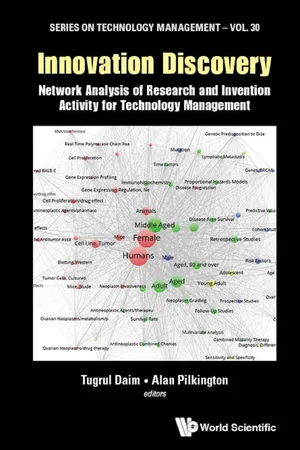
Innovation Discovery
Network Analysis of Research and Invention Activity for Technology Management
- 672 pages
- English
- ePUB (mobile friendly)
- Available on iOS & Android
Innovation Discovery
Network Analysis of Research and Invention Activity for Technology Management
About this book
-->
The use of bibliometrics for the analysis of technology management is on the rise in our increasingly technological societies. Many are using these tools to document or record the rise of various technologies, making it necessary to take stock of the value and application of scientometric methods and their measures.
Innovation Discovery shows the current state of play within the field of management of technology, and discusses how we can use networks to explore, understand and generate theory around the innovation process. It looks at the different streams of analysis used to understand bibliometric data, and presents alternative and novel ways of applying these techniques.
Written as a comprehensive review of approaches by leading researchers in the field, this book is suitable for graduate and post-graduate students and researches looking to expand their knowledge and embark on further investigations in technology management.
--> Contents:
- Part 1:
- Bibliometrics: The Case of Comparing an Ecosystem Using System and Network Approaches (Marco Tregua, Anna D'Auria, Tiziana Russo Spena, and Francesco Bifulco)
- Bibliometrics and Patents: Case of Forecasting of Biosensor Technologies for Emerging Point-of-Care and Medical IoT Applications (Nasir Jamil Sheikh, and Omar Sheikh)
- Patents: The Case of Exploitation of the Patent System Among SMEs and Private Inventors in Finland (J Talvela, M Karvonen, and T Kässi)
- Patents: Case of Analyzing Technological Knowledge Diffusion Among Technological Fields Using Patent Data: The Example of Microfluidics (Zheng Qiao, Lu-Cheng Huang, Fei-Fei Wu, Dan Wu, and Hui Zhang)
- Part 2:
- Patents and Networks: Case of Discerning the Evolutionary Nature of Technological Change in the Complex Product Industry (Fei Yuan and Kumiko Miyazaki)
- Patents and Networks: Case of Identification of Core Industry Actors for Electric Vehicle Battery by Application of Knowledge Flow (Yuan Yuan Shi and Tugrul Daim)
- Patents and Networks: Case of Social Network Analysis for Innovation (Antonello Cammarano, Mauro Caputo, Emilia Lamberti, and Francesca Michelino)
- Patents and Networks: Case of Cochlear Implant Technology Evolution Using Patent Classification Data (Srigowtham Arunagiri and Mary Mathew)
- Part 3:
- Bibliometrics and Networks: Case of a Multinational Perspective on How Eco-Innovation has Evolved in Academic Literature (Blanca de-Miguel-Molina, María de-Miguel-Molina, María-del-Val Segarra-Oña, and Ángel Peiró-Signes)
- Bibliometrics and Social Network Analysis Supporting the Research Development of Emerging Areas: Case Studies from Thailand (Nathasit Gerdsri and Alisa Kongthon)
- Bibliometrics and Networks: Trends and Typology of Emerging Antenna Propagation Technologies (Yasutomo Takano, Yuya Kajikawa, and Makoto Ando)
- Bibliometrics and Networks: Case of Project Management and the Emergence of a Knowledge-Based Discipline (Alan Pilkington, Kah-Hin Chai, and Le Yang)
- Part 4:
- Emerging Networking Methods: Innovation Intermediaries in Technological Alliances (Calvin S Weng)
- Emerging Networking Methods: Analysing Funding Patterns and Their Evolution in Two Medical Research Topics (Blanca de-Miguel-Molina, Scott W Cunningham, and Fernando Palop)
- Part 5:
- Advanced Methods: Identifying the Technology Profiles of R&D Performing Firms — A Matching of R&D and Patent Data (Peter Neuhäusler, Rainer Frietsch, Carolin Mund, and Verena Eckl)
- Advanced Methods: Identification of Promising High-Tech Solutions with Semantic Technologies: Energy, Pharma, and Other Industries (Irina V Efimenko, and Vladimir F Khoroshevsky)
- Advanced Methods: Operationalizing Social Network Services Data — Deep Content Analysis to Comprehend Brand Presence (Arash Hajikhani and Jari Porras)
- Advanced Methods: Technological Frontiers and Embeddings — A Visualization Approach (Scott W Cunningham, Jan H Kwakkel, and Sertaç Oruç)
- Advanced Methods: Opportunities and Potential of the Internet of Things for Solving Social Issues (Yasutomo Takano and Yuya Kajikawa)
- Advanced Methods: Exploring Technology Convergence as a Measure of Transition Toward Connected Lighting System (Nina Chaichi and Tugrul Daim)
-->
--> Readership: Graduate and post-graduate students and researches looking to expand their knowledge in bibliometrics, social networks, tecnology innovaiton and technology management. -->
Keywords:Bibliometrics;Technology Management;Patents;Innovation;Scientometric;Network Analysis;Network ToolsReview:0
Frequently asked questions
- Essential is ideal for learners and professionals who enjoy exploring a wide range of subjects. Access the Essential Library with 800,000+ trusted titles and best-sellers across business, personal growth, and the humanities. Includes unlimited reading time and Standard Read Aloud voice.
- Complete: Perfect for advanced learners and researchers needing full, unrestricted access. Unlock 1.4M+ books across hundreds of subjects, including academic and specialized titles. The Complete Plan also includes advanced features like Premium Read Aloud and Research Assistant.
Please note we cannot support devices running on iOS 13 and Android 7 or earlier. Learn more about using the app.
Information
Table of contents
- Cover
- Title
- Copyright
- About the Editors
- About the Authors
- Contents
- Introduction
- Part 1
- Part 2
- Part 3
- Part 4
- Part 5
- Appendix I. Expert Identification using Social Network Analysis
- Appendix II. Bibexcel — Quick Start Guide to Bibliometrics and Citation Analysis Alan Pilkington
- Appendix III. Supplementary Material
- Index